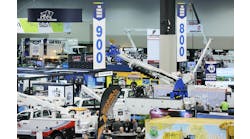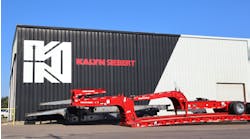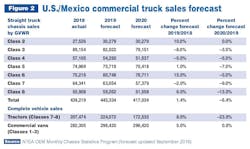The medium-duty market has peaked, but if the economy stays strong, despite ongoing anxiety over Chinese tariffs, and unemployment remains historically low, the inevitable fall won’t prove as severe as in years past.
That was the consensus provided by Freight Transportation Research (FTR) and National Truck Equipment Association (NTEA) experts during a medium-duty update at FTR’s 2019 Transportation Conference in Indianapolis IN.
Don Ake, FTR’s vice president of commercial vehicles, provided FTR’s inventory-burdened perspective, and Steve Latin-Kasper, NTEA’s director of market data and research, shared NTEA’s take on demand in a diverse market segment.
“Inventories have built probably beyond what you could think of as a sustainable level, and you can see that showing up (in Class 4-6),” Latin-Kasper said.
Ake agreed. He said FTR’s analysis of US Class 4-7 inventory compared to retail sales, which shows a growing gap between the two categories, highlights a “troubling” trend he expects will be an issue going forward.
However, several demand drivers could help mitigate the effects of overbuilding. These drivers, with the sector/indicator and 2020 status, include:
Consumer sector: Continued strength (which is good for MD vehicles connected to consumer)
Service expenditures: Slower growth expected (still growing but not as fast)
Consumer durables: Strong, but down from 2019 (if the sector slows too much, it won’t be a driver)
Government purchases: Declining (tax revenues still are high, but after a recent spending binge, they’re buying fewer new vehicles now)
Business investment: Strong, but down from 2019 (the trade war with China makes this driver tenuous)
Industrial: Flat (impacts larger Class 6-7 trucks)
Construction: Moderate growth (can’t rely on to push market forward much)
Unemployment rate: Difficult to go lower (we’ll still see employment growth, but not like last several years)
FTR’s annual forecast has 2019 entering the books as a “great” year, followed by a “gradual downturn” in 2020, when the transportation intelligence firm sees North American OEMs producing 221,700 total units, 136,500 Class 6/7 vehicles and 85,200 Class 4/5 trucks.
“I would consider this a slightly optimistic forecast,” Ake said. “We do have it connected with our economics, which are slightly more optimistic.
“When you look at the production numbers, when you split it into Class 6 and 7, there’s a sharper downturn than 4/5, and then a smoothing out. And we do have 4/5 production increasing a little bit, and stabilizing, because it’s hard to measure the effect but we know there’s the potential … of some of your bigger items that are ordered online, the larger items, needing a Class 4 vehicle for home delivery. That depends on how fast this internet-ordering last-mile comes into play, considering the Class 4 market.”
For 4/5, FTR expects a 0.6% increase year-over-year in factory shipments in 2020, and a 3.8% increase in US retail sales. But it sees 6/7 shipments (-11.9%) and sales (-6.2%) decreasing in 2020 – and all four categories shrinking in 2021 and 2022, with the exception of 6/7 sales in 2022, which it sees staying flat from 2021.
“2022 is the year here where everything catches up, and then we’re hoping that things in 2023 start to recover,” Ake said.
Latin-Kasper opened his presentation by looking at leading indicators like US gross domestic product (GDP), which is decelerating along with commercial truck sales, and CapEx, a measure of capital expenditures as related to personal-consumption expenditures, which he said experienced a “mini-recession” in 2016.“Personal consumption has been holding up at around 2.5% to 3% (increase from the same quarter the previous year),” Latin-Kasper said. “(So) what we’re seeing, in the last … five business cycles, is that each recession we come out of, consumers have less and less left in the bank to be able to bounce back from recession.
“I expect to see CapEx go below zero sometime in the second quarter of 2020 … but CapEx has more impact on Class 8 than it does on medium duty, (which) is a little bit more connected to personal-consumption expenditures.”
North American commercial truck chassis (box-off) sales are approaching 500,000 units for 2019. “NTEA’s data set indicates that we are currently growing, as of June, at 5.2% (for) total box-off sales,” said Latin-Kasper, who added that July was a “very good month” in NTEA’s estimation, too, contracting other forecasts out there.
Commercial van sales in Class 1-3 also are growing “quite nicely” at 9.8%, but segmentation is critical going forward, Latin-Kasper maintained. “As they push toward 300,000 units a year, what’s happening in 2019 is that the standard roof height commercial vans are actually declining in the first half of the year at a rate of about 2%,” he said. “The whole commercial van segment is being held up by the high-roof segment, which, to a certain extent, is cutting into Class 3 and 4 box-off sales.”
Shipments in Class 4-6, the heart of medium duty, have grown in 2019, with Class 5 the biggest propeller, Latin-Kasper said, but sales are decelerating to year-over-year growth below 5%. Comparing shipments to sales, drawdowns of large inventories occurred in 6/7 in 2018, and 2019 looks good so far, especially in Class 3, which Latin-Kasper said is fortunate since sales have been declining in that category.
By NTEA’s velocity measure, a ratio of sales to inventory, Latin-Kasper expects to see continued opportunity for sales growth. Class 4 is growing, but “stabilizing,” Class 5 clearly was overbuilt, and Class 6 peaked early this year.
“We expect to see sales continuing to do well for the industry as a whole through the rest of this year and into at least the first half of 2020,” Latin-Kasper said. “But there are some big warning bells starting to sound going forward for 2020.”
Other indicators for commercial truck sales include state and local equipment expenditures, which NTEA expects to remain strong as tax revenues continue to increase for the next two years, housing starts, which are expected to enjoy a slight increase in 2020, and the yield curve, which Latin-Kasper says isn’t as bad as global business media is reporting.
“(The curve) will likely, by the end of the year or very early in 2020, head below that zero line,” he said. “There are all sorts of warning bells out there indicating that the monthly average of the 10-year T-bill rate will fall below the monthly average of the two-year T-bill rate. When that happens, then we will know an inversion is actually occurring.”
The bottom line—NTEA doesn’t see the same downturn in sales this year that other analysts, including those from IHS Markit, are seeing.
“We think, in total (Class 2-8), it’s going to be 1.4% up (2019 over 2018),” Latin-Kasper said. “In fact, if we’re making an error, we’re on the low side here. The primary reason for thinking we’re going to fall from 5.7% now to 1.4% by the end of the year is very difficult year-to-year comparisons in Class 8 that will drag the industry total down with them. So there’s no way we’re going to hold at 5% to 6%. That’s going to come back down in the fourth quarter. But it may not go quite that far. We may be able to hold at 2%, maybe 3%, for total chassis sales, 2019 over 2018.”
NTEA is more negative about 2020, he said, primarily because of slowdowns in the construction and energy sectors, and decelerating consumer expenditures. NTEA is forecasting negative year-over-year growth in every class in 2020, including a 7 % decline in 5, and 5% drops in 4 and 6 for a total dip of 6.4% in sales in 2020.
“We expect 2020 to be down,” Latin-Kasper said. “(But) if we’re wrong, it’s because it’s likely to be a little bit better than what we’re (showing) right now.”














